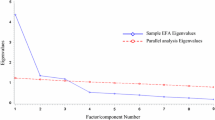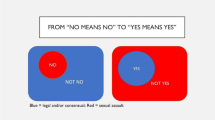Abstract
The current study aims to develop a better understanding of university students’ perspectives, expressions, and use of sexual consent in various situations. A sample of 216 undergraduate students responded to a questionnaire about sexual consent. Using qualitative content analysis, the first author created categories from participants’ responses and the third author then re-coded them to ensure adequate interrater reliability. Many students reported sexual consent as always being important, but this sometimes changed in long-term relationships. Most students reported using verbal cues to indicate their own consent to engage in sexual activities and relied on verbal cues from their partners to indicate consent. However, most students reported using both verbal and non-verbal cues to indicate their own unwillingness to engage to sexual activities and relied on those cues from their partners as well. Students rarely explicitly identified the need for consent to be non-coercive and non-violent or for either themselves or their partner to be aware and conscious when providing consent. Although students usually recognize the importance of sexual consent and engage in mostly healthy practices of consent, some problematic attitudes and behaviours still exist among this population. These results can be useful for enhancing current sexual consent education and sexual violence prevention programs for post-secondary students, ensuring that students feel comfortable giving and obtaining consent in healthy ways.
Similar content being viewed by others
Data and material availability
The data that support the findings of this study are available from the corresponding author upon request.
References
Baldwin-White, A. (2019). “When a girl says no, you should be persistent until she says yes”: College students and their beliefs about consent. Journal of Interpersonal Violence. https://doi.org/10.1177/0886260519875552
Bartoli, A. M., & Clark, M. D. (2006). The dating game: Similarities and differences in dating scripts among college students. Sexuality and Culture, 10, 54–80.
Basile, K. C., & Saltzman, L. E. (2009). Sexual violence surveillance: Uniform definitions and recommended data elements. Atlanta, GA: National Center for Injury Control and Prevention. http://www.cdc.gov/violenceprevention/pdf/.
Braun, V., & Clarke, V. (2013). Successful qualitative research: A practical guide for beginners. Sage.
Callender, K. A., & Klassen, S. (2020). A force to be reckoned with: College women’s experiences with the #MeToo movement. Journal of College Counseling, 23(3), 194–206. https://doi.org/10.1002/jocc.12165
Cantor, D., Fisher, B., Chibnall, S., Townsend, R., Lee, H., Bruce, C., & Thomas, G. (2015). Report on the AAU campus climate survey on sexual assault and sexual misconduct. https://www.aau.edu/sites/default/files/%40%20Files/Climate%20Survey/AAU_Campus_Climate_Survey_12_14_15.pdf
Daigle, L. E., Mummert, S., Fisher, S., & Scherer, H. L. (2015). Sexual victimization on college campuses. In T. Richards & C. D. Marcum (Eds.), Sexual victimization: Then and now (pp. 83–102). Sage.
DeKeseredy, W. S. (2017). Explaining campus violence against women: Unhealthy masculinity and male peer support. In C. Kaukinen, M. H. Miller, & R. A. Powers (Eds.), Addressing violence against women on college campuses (pp. 65–77). Temple University Press.
Hickman, S. E., & Muehlenhard, C. L. (1999). “By the semi-mystical appearance of a condom”: How young women and men communicate sexual consent in heterosexual situations. The Journal of Sex Research, 36(3), 258–272. https://doi.org/10.1080/00224499909551996
Hills, P. J., Pleva, M., Seib, E., & Cole, T. (2021). Understanding how university students use perceptions of consent, wantedness, and pleasure in labeling rape. Archives of Sexual Behaviour, 50(1), 247–262. https://doi.org/10.1007/s10508-020-01772-1
Hills, P. J., Seib, E., Pleva, M., Smythe, J., Gosling, M.-R., & Cole, T. (2020). Consent, wantedness, and pleasure: Three dimensions affecting the perceived stress of and judgements of rape in sexual encounters. Journal of Experimental Psychology: Applied, 26(1), 171. https://doi.org/10.1037/xap0000221
Hsieh, H., & Shannon, S. E. (2005). Three approaches to qualitative content analysis. Qualitative Health Research, 15(9), 1277–1288. https://doi.org/10.1177/1049732305276687
Humphreys, T. (2007). Perceptions of sexual consent: The impact of relationship history and gender. Journal of Sex Research, 44, 307–315.
Humphreys, T. P., & Kennett, D. J. (2011). Reasons for consenting to unwanted sex scale. In Fisher, T. D., Davis, C. M., Yarber, W. L., & Davis, S. L. (Eds.), Handbook of Sexuality-Related Measures (3rd ed., pp. 176–178). Sage.
Humphreys, T. P., Muehlenhard, C., Peterson, Z., & Jozkowski, K. (2017). Understanding the complexity of sexual consent: Normative attitudes and behaviors in university women and men. The Journal of Sexual Medicine, 14(5), e235. https://doi.org/10.1016/j.jsxm.2017.04.131
Jozkowski, K. N., Manning, J., & Hunt, M. E. (2018). Sexual consent in and out of the bedroom: Disjunctive views of heterosexual college students. Women’s Studies in Communication, 41(2), 117–139. https://doi.org/10.1080/07491409.2018.1470121
Jozkowski, K. N., Marcantonio, T. L., & Hunt, M. E. (2017). College students’ sexual consent communication and perceptions of sexual double standards: A qualitative investigation. Perspectives on Sexual and Reproductive Health, 49(4), 237–244. https://doi.org/10.1363/psrh.12041
Jozkowski, K. N., & Peterson, Z. D. (2013). College students and sexual consent: Unique insights. The Journal of Sex Research, 50(6), 517–523. https://doi.org/10.1080/00224499.2012.700739
Knight, R., & Prentky, R. (1990). Classifying sexual offenders: The development and corroboration of taxonomic models. Plenum Press.
Krebs, C. P., Linquist, C. H., Warner, T. D., Fisher, B. S., & Martin, S. L. (2007). The campus sexual assault (CSA) study. U. S. Government Printing Office. https://www.ojp.gov/pdffiles1/nij/grants/221153.pdf
Kumar, M. M., Lim, R., Langford, C., Seabrook, J. A., Speechley, K. N., & Lynch, T. (2013). Sexual knowledge of Canadian adolescents after completion of high school sexual education requirements. Paediatrics & Child Health, 18(2), 74–80.
MacDougall, A., Craig, S., Goldsmith, K., & Byers, E. S. (2020). #consent: University students’ perceptions of their sexual consent education. The Canadian Journal of Human Sexuality, 29(2), 154–166. https://doi.org/10.3138/cjhs.2020-0007
Marcantonio, T. L., Jozkowski, K. N., & Lo, W.-J. (2018). Beyond “just saying no”: A preliminary evaluation of strategies college students use to refuse sexual activity. Archives of Sexual Behavior, 47(2), 341–351. https://doi.org/10.1007/s10508-017-1130-2
Marcantonio, T. L., Valdez, D., & Jozkowski, K. N. (2021). An assessment of the cues college students interpret from a sexual partner to determine they are refusing. Journal of Interpersonal Violence. https://doi.org/10.1177/0886260521997930
Masters, N. T., Casey, E., Wells, E. A., & Morrison, D. M. (2013). Sexual scripts among young heterosexually active men and women: Contunity and change. Journal of Sex Research, 50(5), 409–420. https://doi.org/10.1080/00224499.2012.661102
McOrmond-Plummer, L., Easteal, P., & Levy-Peck, J. Y. (2014). The necessity of appropriate service response to intimate partner sexual violence. In L. McOrmond-Plumer, P. Easteal, & J. Y. Levy-Peck (Eds.), intimate partner sexual violence (pp. 18–29). Jessica Kingsley.
Metts, S., & Spitzberg, B. H. (1996). Sexual communication in interpersonal contexts: A script-based approach. In B. R. Burleson & A. W. Kunkel (Eds.), Communication yearbook (vol. 19, pp. 49–91). Sage.
Muehlenhard, C. L., Humphreys, T. P., Jozkowski, K. N., & Peterson, Z. D. (2016). The complexities of sexual consent among college students: A conceptual and empirical review. The Journal of Sex Research, 53(4–5), 457–487. https://doi.org/10.1080/00224499.2016.1146651
Peat, J. (2001). Health science research: A handbook of quantitative methods. Allen & Unwin.
Powell, A. (2008). Amor fati? Gender habitus and young people’s negotiation of (hetero)sexual consent. Journal of Sociology, 44(2), 167–184. https://doi.org/10.1177/1440783308089168
Rossetto, K. R., & Tollison, A. C. (2017). Feminist agency, sexual scripts, and sexual violence: Developing a model for postgendered family communication. Family Relations, 66, 61–74. https://doi.org/10.1111/fare.12232
Ryan, K. M. (2011). The relationship between rape myths and sexual scripts: The social construction of rape. Sex Roles, 65(11), 774–782. https://doi.org/10.1007/s11199-011-0033-2
Sakaluk, J., Milhausen, R., Todd, L., Lachowsky, N. L., & the undergraduate research group in sexuality. (2014). Dominant heterosexual sexual scripts in emerging adulthood: Conceptualization and measurement. The Journal of Sex Research, 51(5), 516–531. https://doi.org/10.1080/00224499.2012.745473
Sanday, P. R. (1990). Fraternity gang rape: Sex, brotherhood, and privilege on campus. New York University Press.
Shotland, R. L., & Goodstein, L. (1992). Sexual precedence reduces the perceived legitimacy of sexual refusal: An examination of attributions concerning date rape and consensual sex. Personality and Social Psychology Bulletin, 18(6), 756–764. https://doi.org/10.1177/0146167292186012
Simon, W., & Gagnon, J. H. (1984). Sexual Scripts. Society, 22, 53–60. https://doi.org/10.1007/BF02701260
Simon, W., & Gagnon, J. H. (1986). Sexual scripts: Permanence and change. Archives of Sexual Behaviour, 15(2), 97–120. https://doi.org/10.1007/BF01542219
Simon, W., & Gagnon, J. H. (2003). Sexual scripts: Origins, influences and changes. Qualitative Sociology, 26(4), 491–497. https://doi.org/10.1023/B:QUAS.0000005053.99846.e5
Willis, M., Marcantonio, T. L., Jozkowski, K. N., Humphreys, T., & Peterson, Z. D. (2021). Sexual consent at first-time intercourse: Retrospective reports from university students in Canada and the United States. International Journal of Sexual Health. https://doi.org/10.1080/19317611.2020.1862382
Acknowledgements
The authors would like to thank Bruno Gama for his assistance with the preparation and data collection for this study.
Funding
The authors received no specific funding for this work.
Author information
Authors and Affiliations
Corresponding author
Ethics declarations
Conflicts of interest
There is no potential conflict of interest.
Ethical approval
Approval for this study was granted by the Research Ethics Board of the University of Ontario Institute of Technology (Ontario Tech University), REB#14704, on April 4th, 2018.
Consent to participate
Written informed consent was obtained from all individual participants included in the study.
Consent to publish
The authors affirm that human research participants provided informed consent for anonymous publication of data.
Additional information
Publisher's Note
Springer Nature remains neutral with regard to jurisdictional claims in published maps and institutional affiliations.
Supplementary Information
Below is the link to the electronic supplementary material.
Rights and permissions
About this article
Cite this article
Palermo, A.M., Harkins, L. & Campbell, A. Do I Really Need to Ask for a Kiss? University Students’ Perspectives and Expressions of Sexual Consent. Sexuality & Culture 26, 249–267 (2022). https://doi.org/10.1007/s12119-021-09889-8
Accepted:
Published:
Issue Date:
DOI: https://doi.org/10.1007/s12119-021-09889-8




